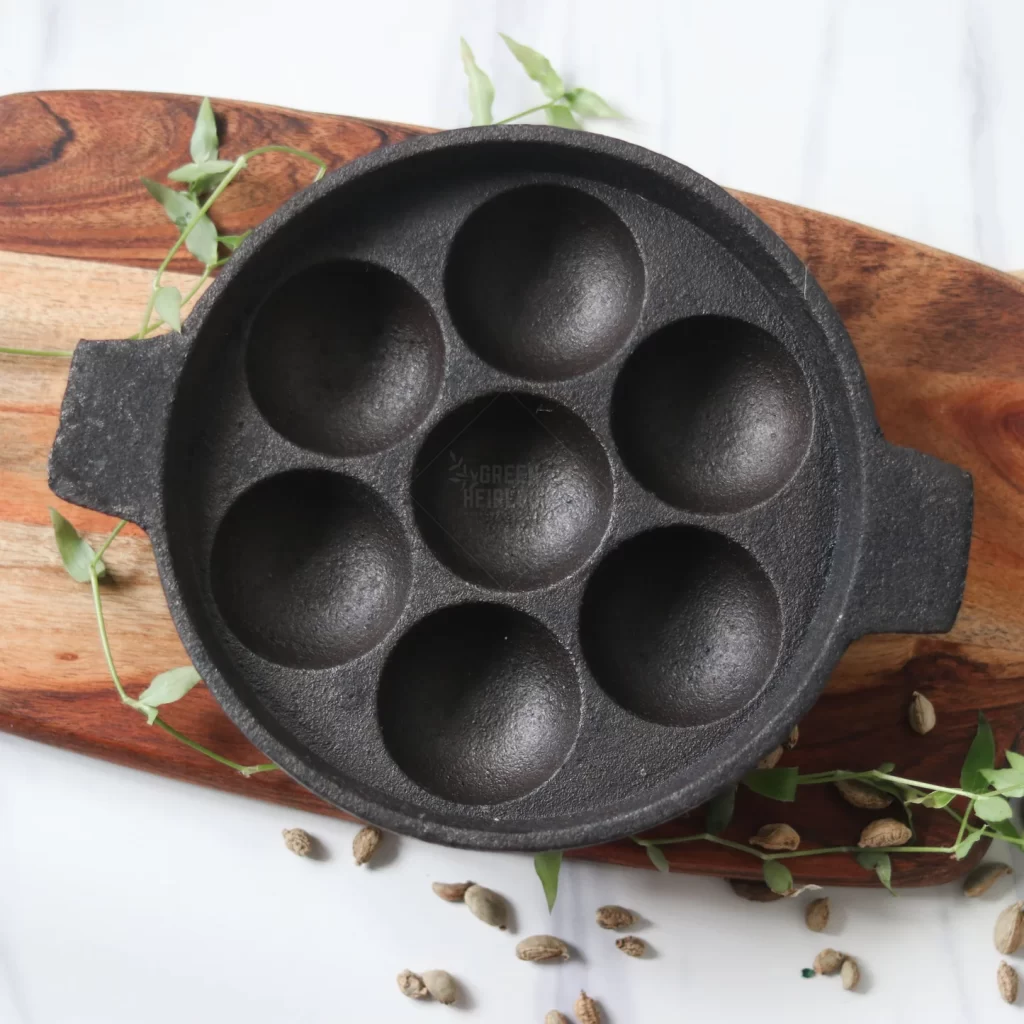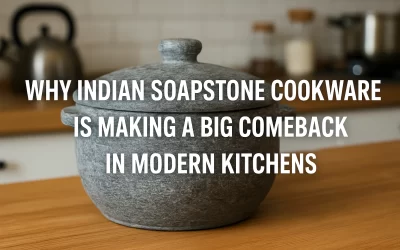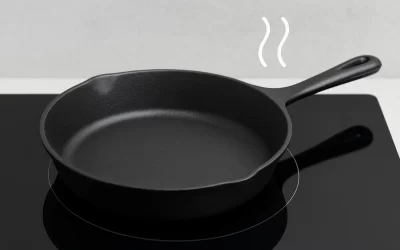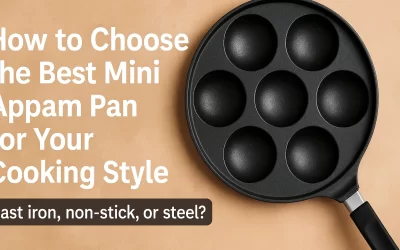Introduction: The Forgotten Powerhouse of the Kitchen

Cast Iron Appam Pan You’ve probably walked past it in a store or seen it gathering dust in your grandma’s cupboard—a round pan with multiple cavities. That, my friend, is the humble cast iron appam pan. While traditionally used for making appams (South Indian fermented rice pancakes), this versatile cookware deserves a permanent spot in your kitchen arsenal—even if appam isn’t on your menu.
Why? Because this underutilized cookware marvel has a range of uses, from crispy egg bites to golden brown fritters. And unlike flimsy non-stick pans, cast iron delivers unbeatable heat retention, natural non-stick qualities, and lasts for generations.
Ready to rethink what your kitchen is missing? Let’s explore everything this powerhouse pan can do. buy cast iron cookware online India
What Is a Cast Iron Appam Pan?
Traditional Origins
The appam pan, also known as paniyaram pan or appe pan, originates from South India. Traditionally made from cast iron, it features multiple round cavities (usually 7 or more) used to cook fermented batter into round, crispy-edged delights. Originally, these pans were essentials in Tamil, Kerala, and Karnataka kitchens.
Modern-Day Uses
Today, the cast iron appam pan has evolved beyond its traditional boundaries. Modern home cooks use it to whip up everything from Japanese takoyaki to Danish aebleskivers—and even mini muffins or falafel balls. It’s the Swiss Army knife of cookware: compact, powerful, and endlessly useful.
Benefits of Using a Cast Iron Appam Pan
Superior Heat Retention
One of the standout features of cast iron is its ability to retain and evenly distribute heat. Unlike thin metal pans that develop hot spots, a cast iron appam pan keeps a consistent temperature throughout, ensuring uniform cooking and browning.
Naturally Non-Stick Surface
With proper seasoning, cast iron becomes naturally non-stick—without the toxic chemicals found in synthetic coatings. That means healthier cooking and less cleanup. Plus, it only gets better with use.
Incredible Longevity
A well-maintained cast iron pan can last for decades. Seriously. With a bit of care, your appam pan might outlive your stove. It’s a cookware investment that pays off over time.
Beyond Appam: Creative Ways to Use the Cast Iron Appam Pan
Think the appam pan is only good for South Indian cooking? Think again! Here are some brilliant ways to get creative:
Mini Pancakes & Crepes
Pour pancake batter into each cavity for perfectly round, bite-sized pancakes. Great for kids, brunch platters, or snacking.
Grilled Veggies & Eggs
Drop in a bit of oil and toss in cherry tomatoes, mushrooms, or crack an egg into each section. The result? Portion-controlled, perfectly grilled delights.
Snack-Sized Fritters
Use leftover batter or make mini veggie fritters, corn cakes, or even meatballs. You’ll get crispy exteriors with tender, juicy centers.
Verdict: While non-stick pans might be easier at first, a cast iron appam pan is more durable, safer, and versatile for long-term use.
Health Benefits of Cooking with Cast Iron Appam Pan

Cooking in cast iron can actually boost your iron intake—especially important for women, athletes, and anyone prone to iron deficiency. When you cook acidic or moist foods, a small amount of iron leaches into the food naturally, offering a nutritional boost.
Additionally, avoiding synthetic coatings means reducing exposure to potentially harmful chemicals like PFOA and PTFE, commonly found in non-stick cookware.
How to Season and Maintain Your Cast Iron Appam Pan
First-Time Seasoning Tips
When you get your cast iron appam pan, you’ll need to season it. Here’s how:
- Wash thoroughly with hot water and a gentle brush.
- Dry completely—moisture is the enemy of cast iron.
- Rub a light layer of high-smoke point oil (e.g., flaxseed or canola) over the entire pan.
- Bake at 400°F (200°C) for an hour upside down. Let cool.
Regular Maintenance Routine
- Wipe clean after each use.
- Avoid soap or steel scrubbers.
- Re-oil lightly if the surface looks dull.
- Store in a dry area to prevent rust.
With consistent care, your pan will develop a glossy, non-stick patina over time.
Best Recipes to Try (That Aren’t Appam)
Cheesy Egg Bites
Mix eggs, cheese, and your favorite veggies. Pour into each cavity and bake or cook on the stove. Perfect for meal prep or lunchboxes.
South Indian Kuzhi Paniyaram
Use leftover dosa or idli batter, add spices and chopped onions, and fry in the appam pan for a delicious South Indian snack.
Japanese Takoyaki Fusion
Why not go international? Use the pan to make takoyaki-style balls—just swap octopus for your favorite fillings!
Choosing the Right Cast Iron Appam Pan
Here’s what to look for when shopping:
- Pre-seasoned Surface: Saves time and effort.
- Sturdy Handle: Ensures safe handling while hot.
- Evenly Shaped Cavities: For uniform cooking.
- Trusted Brands: Lodge, Rock Tawa, or handmade local artisans.
FAQs Cast Iron Appam Pan
1. Can I use an appam pan on an induction stove?
Yes—but make sure it has a flat bottom. Some traditional pans may not be induction-compatible.
2. Is cast iron safe for daily cooking?
Absolutely. In fact, it’s often safer than non-stick cookware when properly maintained.
3. How do I fix a rusty appam pan?
Scrub off rust with steel wool, wash, dry, and re-season. It’ll be good as new.
4. Can I use it in the oven?
Yes, as long as there are no wooden or plastic handles.
5. What oil is best for seasoning?
Flaxseed oil is ideal, but canola and vegetable oils also work well.
6. Is it worth buying if I don’t cook South Indian food?
Yes! Its versatility makes it ideal for all kinds of global recipes.
Conclusion: The Pan You Didn’t Know You Needed
If you’re looking to expand your culinary toolkit, a cast iron appam pan is a surprisingly useful and multi-functional addition. From healthier cooking to better flavor, it delivers serious results. Whether you’re experimenting with new cuisines or sticking to family favorites, this pan is more than just a cultural artifact—it’s a kitchen essential.





0 Comments